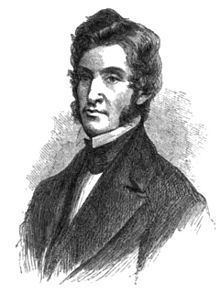Occupation Engineer Name Charles Jr. | Role Civil engineer Siblings Alfred W. Ellet | |
 | ||
Known for Championing suspension bridges and other engineering endeavors in United States Died June 21, 1862, Memphis, Tennessee, United States Education Ecole des ponts ParisTech (1830–1831) Books Military incapacity, and what it costs the country Similar People Charles Henry Davis, John A Roebling, M Jeff Thompson, Washington Roebling | ||
Today In History: Niagara Falls Suspension Bridge
Charles Ellet Jr. (1 January 1810 – 21 June 1862) was a civil engineer and a colonel during the American Civil War, mortally wounded at the Battle of Memphis.
Contents
Biography
Ellet was born in Bucks County, Pennsylvania, son of Charles Ellet Sr. and Mary Israel, and brother of Alfred W. Ellet, also a civil engineer and a brigadier general in the Union Army during the war.

He worked as a rodman, measuring for the Chesapeake and Ohio Canal, making drawings. Benjamin Wright promoted him to Assistant Engineer of the Fifth Residency, but in 1830, he resigned to continue his studies in Paris.
Charles studied civil engineering at École nationale des Ponts et Chaussées in Paris, France, and in 1832 submitted proposals for a suspension bridge across the Potomac River. In 1842, he designed and built the first major wire-cable suspension bridge in the United States, spanning 358 feet over the Schuylkill River at Fairmount, Philadelphia, Pennsylvania. He designed the record-breaking Wheeling suspension bridge over the Ohio River at Wheeling, West Virginia in 1848, and a 770-foot suspension footbridge at Niagara Falls at the same time.
His other civil engineering accomplishments include supervising both the James River and Kanawha Canal in Virginia and the Schuylkill Navigation improvements in Pennsylvania (1846–47), and also constructing railroads in those states. Ellet developed theories for improving flood control and navigation of mid-western rivers. In 1849 he had advocated the use of reservoirs, built in the upper reaches of drainage basins, to retain water from the wet season that could be released during periods of low water to improve navigation; to some degree this also would tend to lessen the level of flooding during high flow. In 1850, the Secretary of War, conforming to an Act of Congress, directed Ellet to make surveys and reports on the Mississippi and Ohio Rivers with a view to the preparation of adequate plans for flood prevention and navigation improvement. His report was very complete, and it exercised considerable influence on later engineering thought and navigation improvements.
In September 1854, the 250-ton SS Vesta accidentally rammed and sank the 2,794-ton SS Arctic. This incident convinced Ellet that with the development of steam propulsion, ramming would be a very effective form of naval combat. He was unable to persuade the U.S. Navy of this, so he published the pamphlet Coast and Harbor Defenses, or the Substitution of Steam Battering Rams for Ships of War in late 1855, hoping to gain the interest of the public.
When the Civil War broke out, he renewed his advocacy. The Navy still ignored him, but in March 1862, Secretary of War Edwin M. Stanton appointed him colonel of engineers, and authorized him to form the United States Ram Fleet on the Mississippi River. Ellis converted several river steamers to rams, and by June his fleet was ready. (As captains of the rams, he appointed his brothers, his nephews, and his son.)
On June 6, he led the rams in the Battle of Memphis as captain of USS Queen of the West. During this complete Union victory, Queen of the West and Monarch rammed and sank the Confederate flagship CSS Colonel Lovell. Ellet was wounded during the battle (the only Union casualty), dying fifteen days later.
Ellet published a Report of the Overflows of the Delta of the Mississippi River, which helped to reshape New Orlean's waterfront. George Perkins Marsh published Man and Nature fourteen years later, but it was Ellet who first noted in writing that the artificial embankments created an overflowing delta. It would be decades later that his assertions were taken seriously and used in flood control decisions.
His son Charles Rivers Ellet was a colonel in the Union Army.
Namesake
USS Ellet (DD-398), which was in service in 1939-46, was named in honor of Charles Ellet Jr. and other members of his family.
